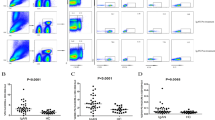Abstract
Background
Renal complications of non-Hodgkin lymphoma encompass a wide spectrum of monoclonal Ig-related pathologies. Clonal circulating T cells can also be associated with non-renal autoimmune disorders induced by overproduction of specific patterns of cytokines or unbalanced lymphocytes sub-populations.
Methods
Immunophenotyping of circulating T cells and TCR gene restriction analysis using Biomed-2 protocol. NF-κB staining and mRNA quantification of inflammatory genes in HK-2 epithelial renal cells exposed to supernatants of peripheral blood mononuclear cells with clonal T-cell population.
Results
Here, we could identify a persistent clonal T-cell population, only characterized by in-depth immunophenotyping of circulating lymphocytes and using multiplex PCR analysis of TCR gene rearrangements, in two patients with polymorphic inflammatory renal fibrosis of unknown origin. Using an in vitro approach, we could demonstrate that peripheral blood mononuclear cells including the clonal population can trigger a phenotype switch of epithelial renal cells from a quiescent state to a pro-inflammatory state characterized by NF-κB nuclear translocation and overexpression of inflammatory cytokine or chemokine.
Conclusion
These preliminary data suggest that circulating T-cell clones may directly activate epithelial renal cells or promote a T-/B-cell population with autoimmune reactive properties against kidney cells, which, in the absence of overt renal lymphoma infiltration, lead to the subsequent inflammatory renal fibrotic phenotype.


Similar content being viewed by others
References
Cohen LJ, Rennke HG, Laubach JP, Humphreys BD. The spectrum of kidney involvement in lymphoma: a case report and review of the literature. Am J Kidney Dis. 2010;56:1191–6. doi:10.1053/j.ajkd.2010.07.009.
Hodgson K, Ferrer G, Montserrat E, Moreno C. Chronic lymphocytic leukemia and autoimmunity: a systematic review. Haematologica. 2011;96:752–61. doi:10.3324/haematol.2010.036152.
Roufosse FE, Goldman M, Cogan E. Hypereosinophilic syndromes. Orphanet J Rare Dis. 2007;2:37. doi:10.1186/1750-1172-2-37.
Lamy T, Loughran TP. How I treat LGL leukemia. Blood. 2011;117:2764–74. doi:10.1182/blood-2010-07-296962.
Fallah M, Liu X, Ji J, Försti A, Sundquist K, Hemminki K. Autoimmune diseases associated with non-Hodgkin lymphoma: a nationwide cohort study. Ann Oncol. 2014;25:2025–30. doi:10.1093/annonc/mdu365.
van Dongen JJM, Langerak AW, Brüggemann M, Evans PAS, Hummel M, Lavender FL, et al. Design and standardization of PCR primers and protocols for detection of clonal immunoglobulin and T-cell receptor gene recombinations in suspect lymphoproliferations: report of the BIOMED-2 Concerted Action BMH4-CT98-3936. Leukemia. 2003;17:2257–317. doi:10.1038/sj.leu.2403202.
Ryan MJ, Johnson G, Kirk J, Fuerstenberg SM, Zager RA, Torok-Storb B. HK-2: an immortalized proximal tubule epithelial cell line from normal adult human kidney. Kidney Int. 1994;45:48–57.
García-Castillo H, Barros-Núñez P. Detection of clonal immunoglobulin and T-cell receptor gene recombination in hematological malignancies: monitoring minimal residual disease. Cardiovasc Hematol Disord Drug Targets. 2009;9:124–35.
Helbig S, Wieczorkiewicz G, Dziaczkowska-Suszek A, Majewski J, Kyrcz-Krzemien M. T-cell abnormalities are present at high frequencies in patients with hypereosinophilic syndrome. Haematologica. 2009;94(9):1236–41.
Roufosse F. Hypereosinophilic syndrome variants: diagnostic and therapeutic considerations. Haematologica. 2009;94:1188–93. doi:10.3324/haematol.2009.010421.
Van den Beemd J, Boor R, Van Lochem PP, Hop EG, Langerak WC, Wolvers-Tettero AW, Hooijkaas IL, Van Dongen H. Flow cytometric analysis of the Vbeta repertoire in healthy controls. Cytometry. 2000;40(4):336–45.
Friedman J, Schattner A, Shvidel L, Berrebi A. Characterization of T-cell large granular lymphocyte leukemia associated with Sjogren’s syndrome—an important but underrecognized association. Semin Arthritis Rheum. 2006;35:306–11. doi:10.1016/j.semarthrit.2005.07.001.
Shvidel L, Duksin C, Tzimanis A, Shtalrid M, Klepfish A, Sigler E, et al. Cytokine release by activated T-cells in large granular lymphocytic leukemia associated with autoimmune disorders. Hematol J Off J Eur Haematol Assoc. 2002;3:32–7. doi:10.1038/sj/thj/6200149.
Jerez A, Clemente MJ, Makishima H, Rajala H, Gomez-Segui I, Olson T, et al. STAT3 mutations indicate the presence of subclinical T-cell clones in a subset of aplastic anemia and myelodysplastic syndrome patients. Blood. 2013;122:2453–9. doi:10.1182/blood-2013-04-494930.
Zhang X, Sokol L, Bennett JM, Moscinski LC, List A, Zhang L. T-cell large granular lymphocyte proliferation in myelodysplastic syndromes: clinicopathological features and prognostic significance. Leuk Res. 2016;43:18–23. doi:10.1016/j.leukres.2016.02.006.
Kondo H, Watanabe J, Iwasaki H. T-large granular lymphocyte leukemia accompanied by an increase of natural killer cells (CD3−) and associated with ulcerative colitis and autoimmune hepatitis. Leuk Lymphoma. 2001;41:207–12. doi:10.3109/10428190109057973.
Author information
Authors and Affiliations
Corresponding author
Ethics declarations
Conflict of interest
The authors declare that they have no conflicts of interests (financial or non financial).
Ethical statement
All procedures were in accordance with the ethical standards of the institutional research committee and with the 1964 Helsinki declaration and its later amendments or comparable ethical standards. This study was approved by our institutional ethical committee (collection NEPHROGENE No. DC-2011-1388, Comité de Protection des Personnes Sud-Ouest et Outremer II, Toulouse, France). For healthy donors (n = 2), peripheral blood mononuclear cells (PBMCs) were isolated from buffy coats obtained through the Etablissement Français du Sang (EFS Midi-Pyrénées, Purpan University Hospital, Toulouse, France). Blood samples were collected and processed after obtaining written informed consent from each donor and approval for this study by the local ethics committee (Comité de Protection des Personnes Sud-Ouest et Outremer II).
Funding
No specific funding.
Electronic supplementary material
Below is the link to the electronic supplementary material.
About this article
Cite this article
Ribes, D., Casemayou, A., EL Hachem, H. et al. Asymptomatic circulating T-cell clone cause renal polymorphic inflammatory fibrosis. Clin Exp Nephrol 21, 781–786 (2017). https://doi.org/10.1007/s10157-016-1373-6
Received:
Accepted:
Published:
Issue Date:
DOI: https://doi.org/10.1007/s10157-016-1373-6




